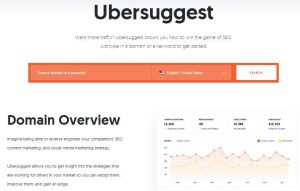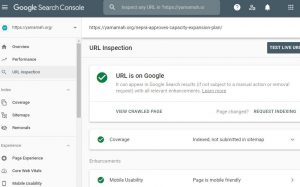There are plenty of free SEO tools out there that you can use to generate more traffic. Sure, you may know a few like Ubersuggest, but there are plenty of options besides my own tools.
- Keyword research
- Content Marketing
- Range tracking
- Link building
- Technical SEO
Keyword research:
All of the tools in this category will help you find more keywords. Many of them have different ways of generating keyword suggestions, so be sure to check them all out.
Ubersuggest has a variety of keyword search options and a free Chrome extension available on SERP. First, it shows how often the keyword has been searched in the last 12 months so you can see the seasonality.
In addition, it pulls keywords from various sources such as Google Suggest and its own database, shows all the keywords that have been rated by the competition, and offers keyword suggestions based on questions, comparisons, and prepositions.
My favorite feature of Ubersuggest keyword search is not only checking the competitiveness of the term but also showing the number of links that are in the average ranking website. That’s how it’s done:
- Step 1: Enter your keywords and click Search
- Step 2: Click Keyword Ideas on the left sidebar.
- Step 3: Click on a keyword from the list provided
- Step 4: Review the data
The average website ranked by Google has 479 backlinks for the keyword phrase “content marketing strategy”. This will give you a good idea of how many links you will need to create in order to increase your rank.
What makes Ubersuggest unique is that it offers local keyword suggestions. This is great if you’re trying to do local SEO.
Respond to the public:
Answer the Public uses Google’s suggestions to find any questions that might be relevant to your industry or keyword.
Just put in a keyword and you’ll see a list of questions people are looking for related to that keyword.
As with Ubersuggest, keywords are also shown for comparison and preposition.
I like this tool because it gives the data a better visual representation than competing tools.
.IO keyword tool:
SEO isn’t unique to Google. It can also rank highly on Amazon, YouTube, Bing, and many other websites.
The .io keyword tool uses the same concept as Google Suggests, but it is used for some websites such as Amazon, Play Store, and YouTube.
If you’re doing SEO on a non-Google site, you need to check out KeywordTool.io.
Then you will see a list of keywords that you could target.
SearchVolume.io:
When doing keyword research, how do you know that your keywords are getting enough searches?
SearchVolume.io lets you upload up to 800 keywords in bulk and see how popular each keyword is.
Content Marketing:
When you need more search traffic, one of the things we all need to create is content.
Here are some free content marketing tools to help you get the most out of your search traffic.
Google Analytics:
If you haven’t used Google Analytics before, we recommend that you get started as soon as possible. No other data source provides high-quality and detailed information like Google Analytics.
In an age of Google domination, we have to work on it. Most other data tools only use the API to consume Google data.
You can’t ignore Google Analytics for SEO and content marketing. Virtually all of the practical and important data about site visitors, traffic, etc. comes from this important source.
Click Flow content dimming:
Have you noticed that your ranking is decreasing over time?
It’s not just Google’s algorithms that have been updated. In most cases, old content is out of date, resulting in poor performance.
First, you need to connect the Content Decay Tool to the Google Search Console.
When Click Flow imports the data, you will see a report showing the pages on the site that lost the most search traffic in the past 12 months.
From there, you can update these posts to make up for lost traffic. Just expand the content, add examples to make it more complete, and remove the old references.
If you choose to upgrade to a paid Click Flow account, you can also measure content updates.
Click Flow shows page by page how updates affect traffic and rankings.
The best thing about this tool is that it saves a lot of time. For example, my team updates 90 pieces of content a month. The last thing you want is to invest a lot of time and resources on content that has never had a lot of traffic.
Google Search Console:
Most people use the Google Search Console to see which keywords are driving traffic.
My favorite way to use the search console is to see which of my blog posts are getting a lot of search impressions, but with a CTR of less than 4%.
Then modify each of these pages to include the appropriate keywords in your meta tags. Then look at the keywords that you have ranked but not yet served and create new content based on those terms or modify existing content for targeting.
Content ideas:
Ubersuggest has similar features to Buzzsumo, but it’s 100% free. It is called a content idea.
Just enter a keyword or phrase and you’ll see all of the popular blog posts that contain that term.
Blog posts are sorted by social content, backlinks, and search traffic.
This helps create content on the topic that people want to read. That means more traffic.
Grammarly:
All SEOs should use Grammarly.
What do you think Google prefers? Want to grade blog posts that are easy to read or blog posts with lots of spelling and grammar errors?
Grammatically helps avoid spelling mistakes. This is very important if you want to rank on Google.
Google SERP preview tool:
Notice that some of the Google lists are cut off because the title is too long?
The big mistake is that Google uses the number of characters in its meta tags. They actually count pixels.
Google’s SERP tool tells you how many pixels there are in the meta tag and if Google is cutting them off.
Range tracking:
Google Analytics is a great tool for viewing traffic in general, but I don’t know where to put it.
If you want to keep track of your ranking, you have to use other (free) SEO tools.
Google search console:
As you know I mentioned this tool earlier, Google Search Console is the most unique rank tracking tool out there.
This tool is developed by Google so you can see the average ranking of each page by country.
Ubersuggest:
I know I mentioned Ubersuggest before, but now there is a free rank tracking feature. You can access it by doing the following:
- Step 1: Enter the URL and click Search
- Step 2: Click on Control Panel on the left sidebar
- Step 3: Click on New Project and run the flow to add the websites and keywords you want to keep track of.
- Step 4: Click on “Keywords Tracked”
- Step 5: monitor your ranking
Also, save the data to go back to where you want to see if the ranking goes up or down.
Link building:
I had to pay for the tool when I needed the link data, but now it’s not. The free link tools you can use are:
MozBar:
This is probably my favorite linking tool.
Google doesn’t use domain permissions, but in general, the higher the permissions on the linking site, the better.
MozBar displays domain and page permissions for all pages on the web.
When creating links, focus on the site with the highest authority.
SEO gadget for Excel:
If you’re like me you’ll love using Excel when creating links.
SEOgadget for Excel makes it easy to get data from Majestic and Moz.
If you haven’t tried it yet, then this is your place to consider. So you can easily find new knowledge and carry out your own calculations.
Backlink:
A backlink is a free tool that shows all of your backlinks. There is no limit to the number of lines, etc. You can see anyone linked to you.
You can filter the results to find backlink opportunities by researching competitors. You can also search for link data by domain, subdomain, or a specific URL.
It also shows the date and time the links were first discovered and last crawled, as well as the permissions for each link.
Tired of manually searching for domains and page permissions on every page or site?
This Domain Authority Checker helps you to check several pages at the same time.
Just add a list of URLs and in a few seconds, you will see a list of page permissions by URL. You can do the same for domains and upload dozens of domains at once.
SEO tool for analyzing employees:
Analytics tools let you enter the URL of a website (any website, not yours) to generate a report.
SEO Workers do not offer anything new, but they can help to save a lot of analysis time. It also provides background information on the data.
Technical SEO:
SEO has changed. You can’t just do a few things anymore and you can’t expect your website to rank well. If you hope to win your competition, you must do whatever you can.
And if I mean everything, it includes technical SEO.
SEO analyzer:
If you haven’t already, try running the URL in your SEO analyzer.
You can see what’s wrong on every website.
Examine almost every important element of SEO, from duplicate meta tags and error redirects to sitemaps.
It shows you how fast your website is overall and what to fix for the best results
When you sign up for a free account, errors are automatically checked weekly.
Google Analytics Referral Spam Killer:
If you’re doing SEO, then referral spam is likely to spoil your Google Analytics.
Google Analytics Referrer Spam Killer solves this problem by connecting to your Google Analytics account and blocking the most common referrer spam.
Page speed insights:
Speed is everything. The faster your website loads, the higher your website will rank, especially when it comes to Google’s mobile index.
Page speed Insights shows what needs to be changed to help your website to load quickly on any device.
Do write to us to know more about Free SEO Tools,






